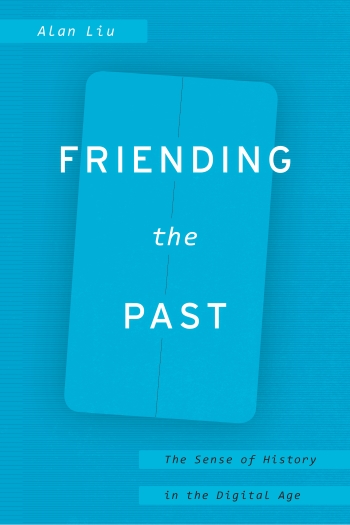| 2018 |
Friending the Past: The Sense of History in the Digital AgeCategories Books Books
|
| Citation: Friending the Past: The Sense of History in the Digital Age. Chicago: University of Chicago Press, 2018.
[336 pages, 49 halftones, ISBN paperback: 9780226451954; E-book: 9780226452005]
|

|
We are the sense of history.
For just this moment—this magical now suspended between our speaking in writing and your hearing through reading—don’t doubt us. Don’t ask how we descended from past into present being. Don’t ask how we can be a being amid today’s plural clamor of social experience. Don’t ask whether our status as merely a sense of history in this time of 24/7 sensational news makes us a poor, pale being—a specter in need of screens to claim attention.
Such questions of doubt—and of not a little wonder, too—were once asked by those like Augustine, Herder, Hegel, Ranke, Nietzsche, Dilthey, Collingwood, Heidegger, Benjamin, Arendt, Braudel, Raymond Williams, Foucault, and others who thought about intellectual history, philosophy of time, and philosophy of history. Memoirists, biographers, novelists, filmmakers, and poets have evoked the same wonder and doubt. And so have hoarser crowds who lived and died in the vanguard, Zeitgeist, or wake of the sense of history: French revolutionary mobs, huddled immigrant masses, modern mass audiences, twentieth- and twenty-first-century refugees, and others of “history from below” or from the margins. Not in philosophical ways but in their rhythms and forms of work, celebration, flight, death, murder, suffering, grief, and amusement, the many questioned and quested for a sense of history. They doubted any sense of history scripted for them from above. They wondered if they could make a sense of history—joyful, bloody, mournful, wry, and wise all at once—that was theirs. This is our time, they said in their character as plural, modern humanity. As personal as a sick day taken to care for oneself or one’s family, or as collective as July 14, September 11, and other dates of shared commemoration, our time was when the modern many restored itself to a larger, fuller sense of history. It was the curative, if sometimes also wounding, pause in the teeming life of history that revealed the sense of history.
So, as today’s sense of history, we ask you to give us the benefit of your doubt. For now—this suspended, shared time of our speaking and your hearing—do not question that we are. Instead, just ask one question that for our time may well condense all the wonder and doubt of earlier existential questions: How are we speaking to you, and you listening to us, at all?
This is the media question, though really “media” is just one especially enchanting member of a litany of terms we will soon need to chant. Today, the media question affects the sense of history to the core. After all, since everything you now know of us comes from our speaking in writing to you, and what we know of you comes from our imagining your listening, through reading, to us, the possible modes of our common speaking and listening are central to what we seem, even to ourselves, to be. This is not just an abstract existential issue. It’s ethical, political, and in other ways critical, too. Have we chosen the best way to speak the sense of history today, and if so, for the benefit of whom? Did we even choose, or are we just channeling some natural, social, economic, political, corporate, or (God knows) transcendental agency that chose for us according to its own interests?
Just choosing the right terminology for discussing how we are speaking to you, and you listening to us, is an absorbing problem. What should we even call our present shared act of “speaking” and “listening” (or, if you prefer, “writing” and “reading”), since these are clearly just metaphors for whatever is happening in today’s messy remediation of oral, audio, written, printed, graphic, filmic, electronic, and digital media? Or, to raise the question to its general level (here comes the chant of terms we promised): shall we call our speaking and listening rhetoric, representation, interpretation, communication, information, or (already cued up) media? It is worth pausing on these vocabulary choices, since the historical shifts in meaning and weight among them capture so well the fragility we feel about ourselves as a sense of history. Frankly, we have lost confidence in the ability of any of these terms to sustain, let alone spread, the sense of history. Each of these six terms differs from, yet shades into, the others, and each applies to all eras. Yet they might grossly be classed into two regimes based on the epoch when their concepts had the broadest socio-political and socio-economic impact. The earlier regime can be referred to as rhetoric-representation-interpretation. The later we will speak of as communication-information-media. . . .
. . . I previously demonstrated what a close reading of the front-end interface of the Romantic Chronology TimelineJS might show that is of humanistic interest, and I followed with a similar demonstration of what a close reading of the timeline’s back-end data source might illuminate. Then I performed a technical, but not yet humanistic, close reading of TimelineJS’s JavaScript middleware and client-side code connecting the back end to front end. To grasp fully the significance of the JavaScript-manipulated <div> tag in TimelineJS, which the latter close reading puts the spotlight on, now requires that we complete the exercise by taking a fresh perspective on TimelineJS’s JavaScript code—the most recalcitrantly technical object of my reading so far—in humanistic, even poetic terms. As I earlier foreshadowed, this is where a close reading of the digital era’s sense of history as expressed in TimelineJS must grow speculative, imaginative.
Since one of the main premises of close reading in the mode of the New Critics is that form and content ineluctably inflect each other and cannot be read separately, the best way to imagine the humanistic potential of TimelineJs’s JavaScript is to think together about its code, which literally creates form (the DOM), and the Romantic content of my reimplemented Romantic Chronology timeline. What follows, therefore, is an experimental co-reading—sensitive at once to similarity and difference—of JavaScript and the Romantic Zeitgeist. This is how I will come to the recognition, or imagination, that is implied in the title of this final chapter: that the contemporary sense of history is both like those of earlier periods (including Romantic-era Historismus) and, as implied by the weakness of “like” compared to copular “is,” also crucially, speculatively unlike.
Where to start in demonstrating how to close-read the TimelineJS JavaScript code and the Romantic spirit of the times in tandem? To take advantage of the fact that my earlier scholarship specialized in the work of William Wordsworth, I offer a co-reading of TimelineJS’s JavaScript and Wordsworth’s poetry. Much of my Wordsworth: The Sense of History concerned the Romantic understanding and experience of temporality (for example, part 2 of the book, “Violence and Time”). Here, for the purpose of selective illustration, I take as a starting point just some well-known passages from Wordsworth’s poetry that bear on the experience of time. . . .
. . . I asked at the start of chapter 1: “Can we be friends with the past? If so, will the past friend us? What philosophy of history—at root, a ‘love’ in the way we know the past—can make such amity possible in an information age when our craving for instant data binds us to an ever more expansive, yet also vanishingly thin, present—a razor’s slice of now big enough for each of us to have a thousand Facebook friends or Twitter followers, so long as all that friendship fits on a few screens of attention before rolling off into oblivion?”
This book has been about how the digital present might have a love—and a philosophy—of history. Let me end with the assertion that the digital networked age does have a sense of history, and that this sense can be friends with past senses of history. But the principles of that amity—of likeness between the parameters of our sense of history and those of other eras and peoples—have as much to do with difference as sameness. We will not know why, how, when, where, and who we are in history until we have more fully taken the measure of our sense of history in relation to others who are like us but different in their way of being in, and sensing, history—who, indeed, are like us in being different in that way. After all, only such comparison, which is also contrast, gives meaning to the act of measuring, whether conducted through close or distant reading, since we would not need to measure if two points either coincide or lie in dimensions so dissimilar that there is no common measure. In the meantime, we can hope that liking, as on a social media network, can at once shape and be shaped by systems of media, communication, and information that have it in them to be like a sense of history—one that knows itself to be both like and unlike others in time and space. This would be to own, and be responsible for, our sense of history—one that, whether in a network or other historically lived plenum of media, communication, or information, is able to respond when called across time and space by another.
